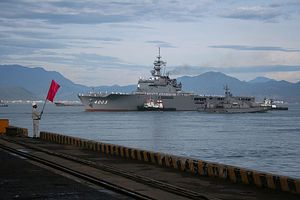Last week, amidst the flurry of meetings during the ASEAN Defense Ministers’ Meeting (ADMM) and the ASEAN Defense Ministers’ Meeting Plus (ADMM-Plus) in the Philippines, the defense ministers of Japan and Vietnam met for a bilateral meeting. Though the meeting was just one of the several in the growing interactions by the two countries, it did offer an opportunity to take stock of where the relationship is and where it might be headed.
As I have noted before in these pages, Japan and Vietnam have been boosting their defense ties as part of their broader extensive strategic partnership over the past few years, in part though not exclusively due to concerns about a more assertive China. Vietnam sees Japan as a critical player to engage as part of its wider omnidirectional foreign policy, and Tokyo views Hanoi as an important node in its enhanced engagement with Southeast Asia more broadly, including in the defense realm following the lifting of decades-old restrictions in its military export ban (See: “The Future of US-Japan-Vietnam Trilateral Cooperation”).
Over the past few years, we have seen some significant developments in the defense side between the two actors. This has included not just growing Japanese maritime security assistance to Vietnam which often dominates the headlines, but a growing list of firsts such as starting new naval drills, facilitating Japanese port calls to the Southeast Asian state, inking an agreement on closer coast guard cooperation, and eyeing future opportunities for defense industrial cooperation (See: “Japan Reveals First ASEAN Defense Initiative With Vientiane Vision”).
Japanese Defense Minister Itsunori Onodera’s meeting with his Vietnamese counterpart Ngo Xuan Lich was an opportunity to discuss regional and global issues of common interest, to take stock of bilateral ties, and to assess the trajectory of the relationship. On regional and global issues, Onodera said that the two countries had especially touched on North Korea as well as maritime security and freedom of navigation, a mutual concern for both sides in the East and South China Seas.
The more interesting developments were on the bilateral side. Take naval exchanges, for instance. The relationship has already seen some significant developments in this realm, including bilateral drills as well as Japan’s unsurprising inclusion on the list of foreign countries making port calls to the new port facility that Vietnam had opened for foreign warships in Cam Ranh Bay.
But Onodera publicly disclosed what many had suspected: that the Vietnam side had indicated that it was willing to revise a once-a-year restriction for ships from a foreign country to allow multiple port calls by Japanese ships in Cam Ranh in recognition of the special nature of the relationship (See: “Vietnam Unveils New Port Facility for Foreign Warships in Cam Ranh Bay”). As I have noted before, Japan is not the only country that has been trying to get around this technical restriction through various ways in recognition of changing regional realities and alignments (See: “US-Vietnam Defense Relations: Problems and Prospects”).
Onodera also hinted that there might be some progress on defense equipment and broader defense industrial collaboration. To be sure, cooperation in this realm is not new. Japan has already begun providing Vietnam with maritime security assistance as well as specific kinds of equipment such as patrol vessels. Vietnam and Japan have also already been discussing prospects for collaboration on this front and attempting to better understand each side’s procurement and defense industrial capabilities. Just earlier this month, for example, the two countries held a defense industry forum to discuss the subject involving their defense ministries.
Though Onodera did not disclose much in the way of specifics, Onodera did say that both sides were now discussing cooperation on specific kinds of defense equipment. The shape of cooperation in this sphere, he said, would include capacity-building as well as other areas like aviation medicine given the capabilities of Japan Self Defense Forces (JSDF hospitals in Japan. Given how cooperation has developed so far, we can expect this to include a range of systems in the maritime security realm, though unveiled in a calibrated and balanced fashion aligned with Vietnam’s comfort level.

































